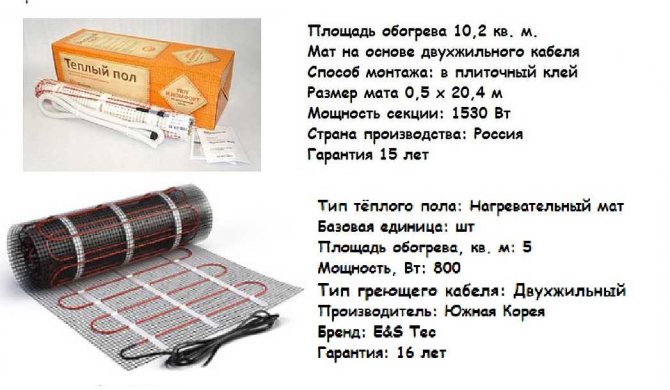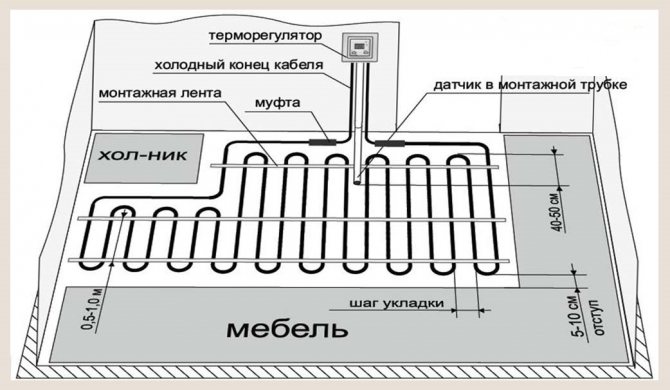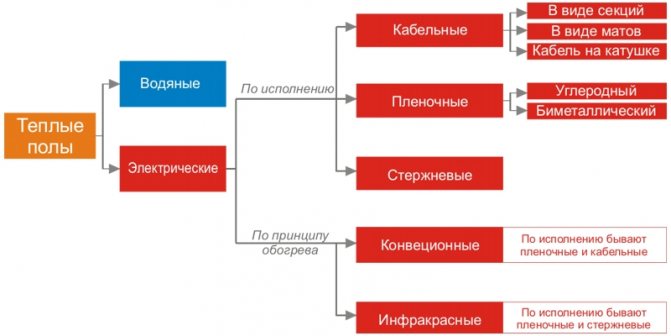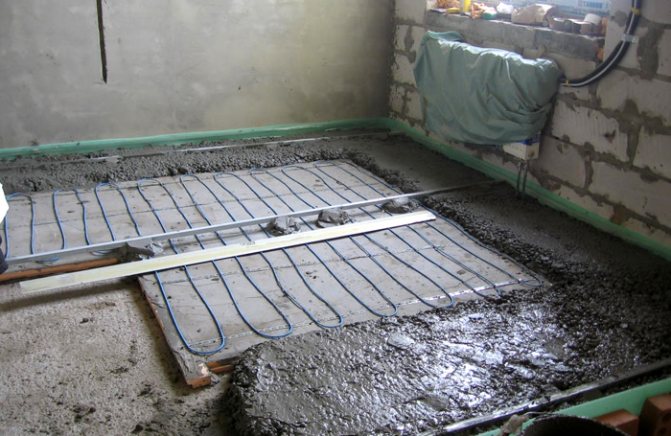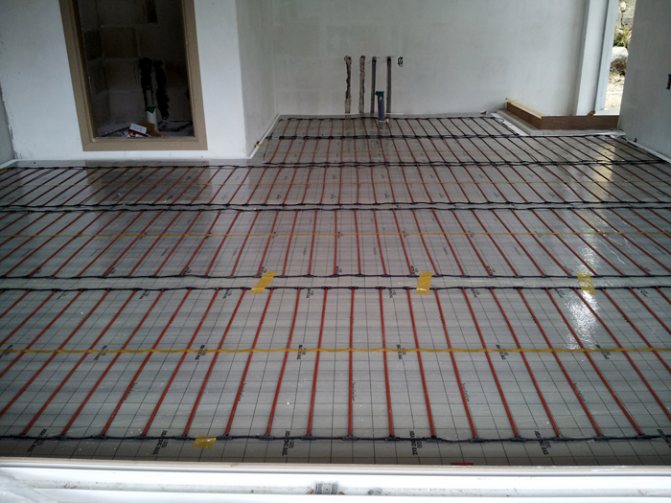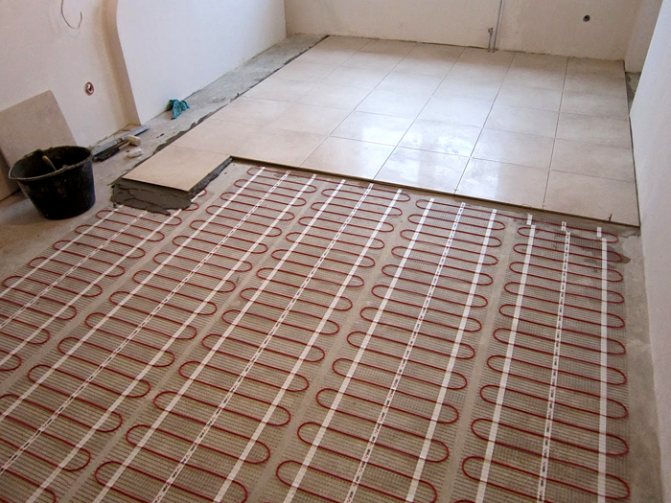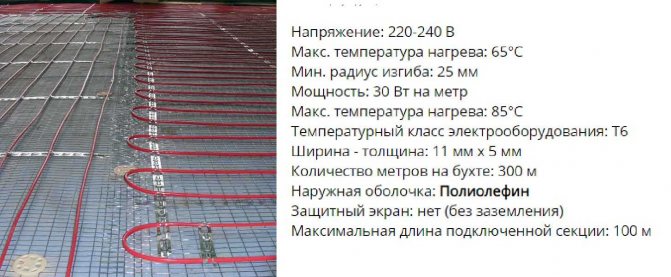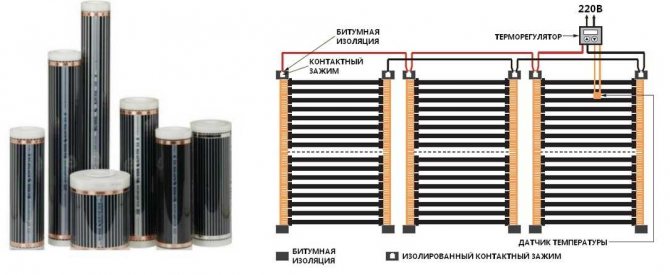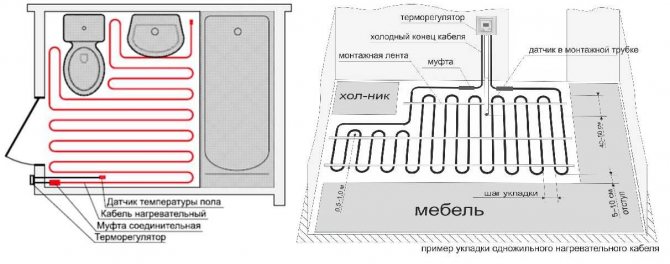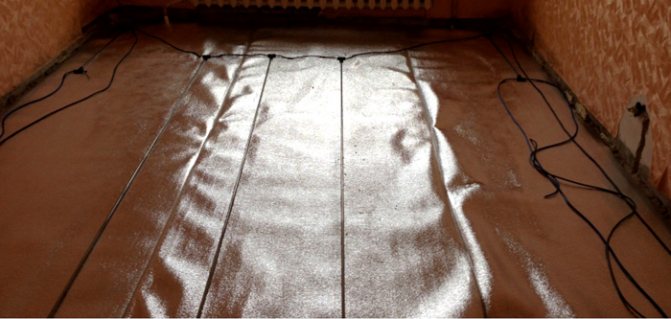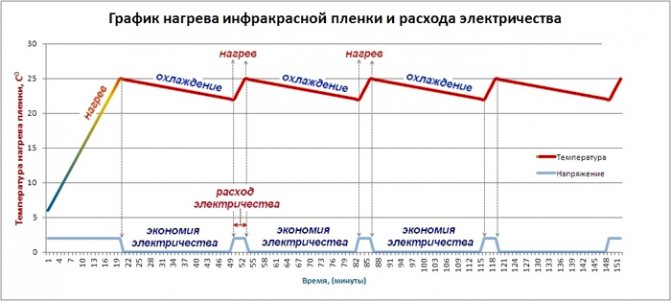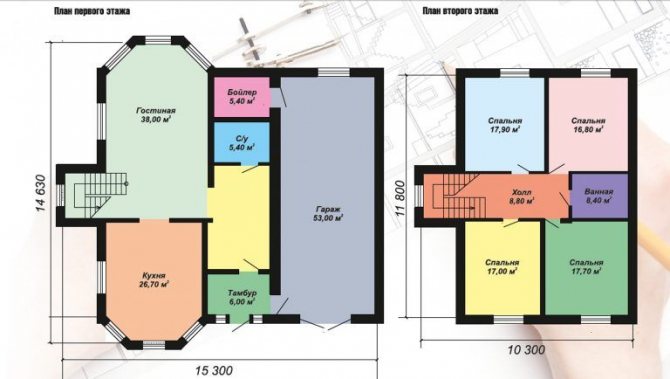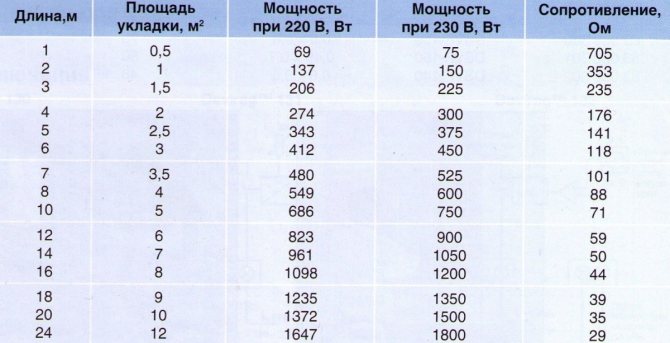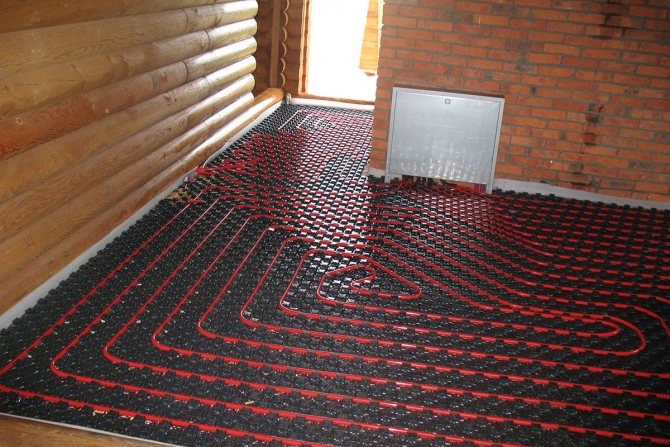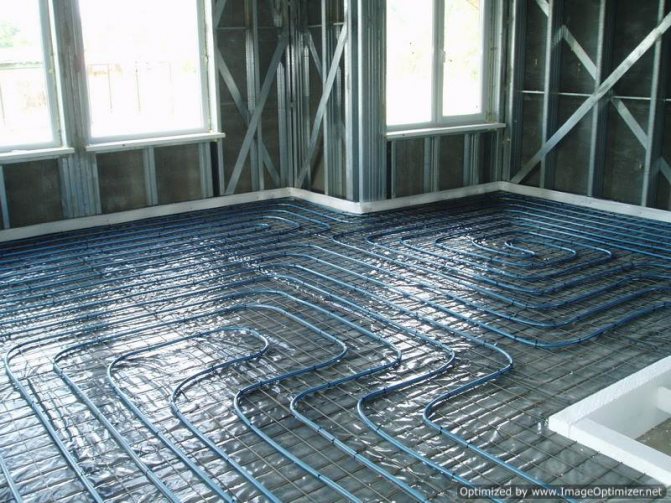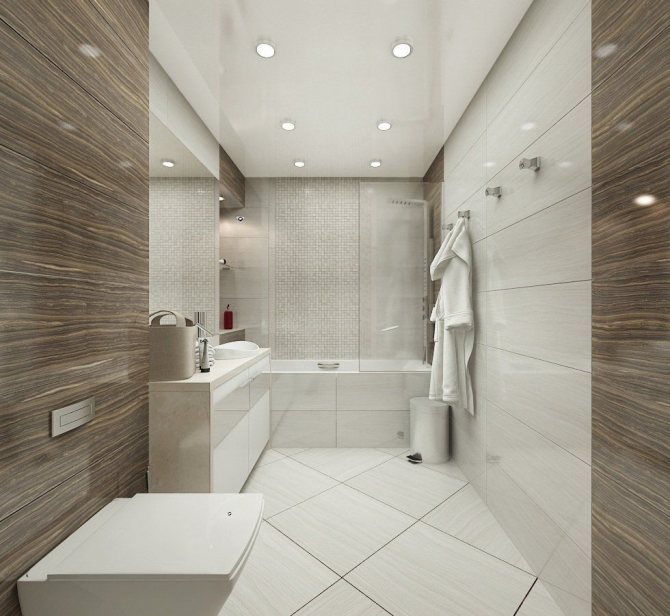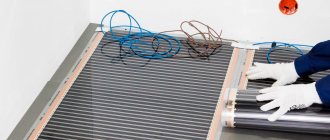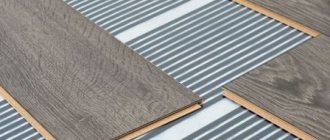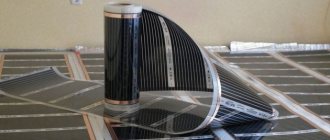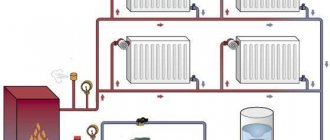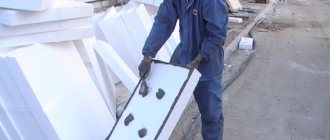Features of the film underfloor heating
High power consumption has always been a disadvantage of any electric heating. A traditional boiler with batteries connected to it devours a wild amount of electricity, making the meters literally fly up due to the high consumption. And the larger the area of home ownership, the greater the costs.
Heating equipment developers are working hard to reduce energy consumption. For example, in technology, precise electronic thermometers are used, experiments are carried out with a coolant and methods of heating it. Film warm floors have become an interesting and economical solution. Demanding a minimum of labor for their installation, they provide rooms with comfortable warmth.
Infrared heating equipment is considered economical. This is not to say that electricity consumption is reduced in a downright dramatic way, but in general, costs are reduced by 20-40%. Considering the high cost of electric heating, the amount of savings will be significant. It should also be noted that the minimum cost of installing film warm floors. Only now you have to spend money on the film itself.
Let's look at the main features of film warm floors:
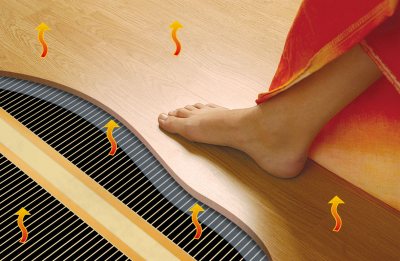
The film can heat kitchens, corridors, hallways, children's rooms, bedrooms and any other premises.
- Economical energy consumption - after working on the thermal insulation of your home, it can be reduced by another 10-15% of the original value;
- A large selection of films of various capacities - for work as a main or auxiliary heat source;
- Film warm floors give soft heat, do not burn oxygen and do not have a negative effect on human health;
- Infrared film does not require a powerful screed, which further reduces energy consumption and eliminates inertia.
Rules for laying IR underfloor heating
It is necessary to adhere to a few simple rules for laying IR underfloor heating:
- The first line of the film should be located at a distance of at least 100 mm to the wall and no further than 400 mm.
- The step of the film cutting line is 250 mm, in other places it is impossible to cut the film.
- The distance between adjacent strips of film should be 10 mm and more.
- The permissible length of the floor strip is 8 m.
Under the laminate
When laying a film underfloor heating under a laminate, follow the rules:
- To prevent the infrared film from overheating, it must be distributed in areas where there is no furniture.
- In order for the room to warm up with maximum efficiency, the film floor must cover an area of at least 70%.
Installation scheme for IR underfloor heating for various types of topcoats floor
Next, you need to draw a plan for the location of the heating elements. On paper, reflect the locations of the furniture and heating film.
Laying is done on a surface that is leveled before that.
The concrete screed must not have any drops. To prevent the heat from escaping from the thermal film, a thermal insulating substrate (polypropylene), 3-4 mm thick and covered with foil on one side, must be laid on the floor through the floor slabs to the neighboring apartments.
The strips of thermal insulation are fixed with thermal insulation tape, and they must also be carefully trimmed around the perimeter of the room.
The heating foil can only be cut in the places indicated on it. They are highlighted with a dotted line and a scissors symbol.
Cutting the film diagonally will ruin it.
The distance of the film from the wall should be at least 10 cm.
The heating film strips are placed on the substrate one next to the other with a gap of at least 5 mm, but not more than 1 cm.
It is impossible to bend the heating element at an angle of 90 degrees or more, as it will cease to function.
Wiring diagram for IR underfloor heating
In places where the thermal film is cut and conductive busbars are cut, it is necessary to perform bitumen insulation, which is included in the underfloor heating kit. The contact must be placed in the center of the end of the busbar and pressed well with pliers. Using a sharp knife, it is necessary to strip the current-carrying wires by 5-8 mm and clamp them with pliers in the contact terminal, then the entire contact is insulated with bitumen insulation. An infrared warm floor is connected in parallel with copper stranded wires with a cross section of at least 1.5 mm². It is also recommended to install a thermal sensor in order for the floor heating automatics to work correctly.
At a distance of 20-25 cm from the wall on which you will install the thermostat, using a puncher, perform a chasing. Place the temperature sensor in the hole formed under the heating foil.
For the sensor to show the correct temperature, it must be placed on a heat-insulating substrate.
After all the above manipulations, the thermostat is connected.
Upon completion of the installation, check the functioning of the IR underfloor heating. All thermal films should be heated when turned on. Only after making sure you can lay the laminate on the heating elements.
Under linoleum
Laying under linoleum is similar, but it also has its own characteristics:
- At the first stage, prepare the base, because the floor can be mounted exclusively on a flat and stable surface.
- The mats can be cut into 25 cm pieces. The edge is insulated with a special tape. The gap to the pipes of the heating system should be from 30 cm.
- It is necessary to lay the film with copper busbars upwards; it is strictly forbidden to lay joints one on top of the other. The rest of the steps are carried out in accordance with the instructions. A prerequisite for high-quality heating is the connection of a thermostat.
- Then linoleum spreads. In rooms that are small in size, the coating is laid and left for a couple of days, after which the edges are pressed with plinths.
Linoleum can be laid in different ways. When performing work, take into account the fact whether it will be necessary to disassemble and transfer the system in the future, and also pay attention to the technical characteristics of underfloor heating.
As you can see, infrared film underfloor heating is an excellent option for a heating system, and its installation is not so difficult. Therefore, everything can be done by hand.
Energy consumption of underfloor heating
The energy consumption of an infrared film underfloor heating is calculated using the simplest formulas. Before installation, it is necessary to decide how the film will be used - as the main source of heating or as an auxiliary source of heat in addition to radiators, batteries and other devices.
If the film heat-insulated floor will act as an addition, you will need a film with a power of 150 W / sq. m. To work in independent mode, its power should be 200-220 W / sq. m. If the room is cold, and even damp, we increase the capacity to 300 sq. m. As a basis for our calculations, we will choose two samples - with a power of 150 and 220 W / sq. m. Let's see how much the warm floor consumes electricity per month, in kilowatts.
First, you should calculate the area of the film warm floors themselves. We are not particularly interested in the area of the room, but the calculations are carried out for rooms with a ceiling height of up to three meters. Usually, the film is not located under the entire area of the premises - under beds, sofas and wardrobes, it is not needed, since here it can be damaged as a result of elementary overheating.Therefore, before making calculations, you need to draw up a plan and decide where the infrared film will lie and how much it is needed.
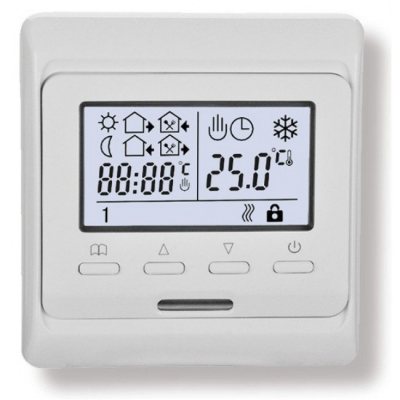

The figures presented are valid for round-the-clock operation of film warm floors, but in practice they work in intermittent mode, obeying the thermoregulation system.
Let's assume that the area of our household is 100 square meters. m. Of this hundred, about 20% of the entire area is allocated for furniture. The total area of the infrared film in the house is 80 sq. m. If it is used as the main source of heat, the daily electricity consumption of the underfloor heating will be 17.6 kW. For the auxiliary source, the consumption will be 12 kW.
The main underfloor heating consumes a maximum of 528 kW of electricity per month, the auxiliary one - 360 kW. The numbers are quite tolerable, but they are not entirely correct. Should be considered:
- Heat loss level in a heated building;
- The presence of thermoregulation and the temperature set on it;
- The nature of the use of the residential building.
Film underfloor heating: electricity consumption, reviews, use as the main heating
There is a lot of advertising information on the network about how much electricity a warm floor consumes per month. Undoubtedly, most of the data is true, but a lot of details have not been announced. Let's calculate the electricity consumption of an infrared heated floor in a standard house with dimensions of 100 m 2 using a calculator.
Note! There are samples with different power from 110 to 220 W / m 2. That is, how much does one square meter of insulating material consume electricity per hour. Values 110-160 W are used as heating only the floor covering, 180-220 W is more powerful equipment that can act as the main heating.
In our example, a sample with a power of 220 watts. Since the material does not fit under heavy and low furniture (the recommended gap is at least 4 cm), 70% of the total area is taken as the standard for calculations. So, we need 70 m 2 of heating material. This type of heating is not constantly at the stage of electricity consumption, since the thermostat turns off and turns on the system when the set temperature is reached. But if the user, for example, lives in Surgut, where in the cold season the temperature drops to -45 ° C, and there are no cold cutters on the windows in the form of batteries, then the heating will be turned on almost 24 hours a day.
Note! Heat loss at home should also be included in this category, that is, how carefully it is insulated.
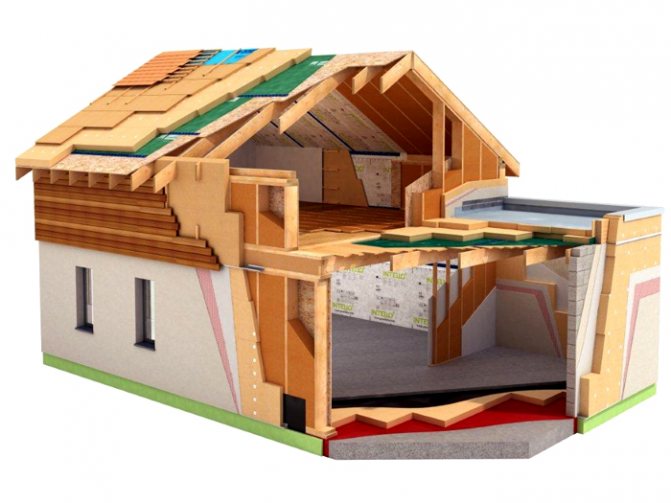

House insulation scheme
Thermoregulation and more real numbers
The energy consumption of electric underfloor heating is reduced by installing a thermostat. Without it, the surface temperature of the flooring would be too high and not very comfortable. The thermostat monitors the temperature of the finished floors, turning the power on and off as needed. Depending on the level of heat losses, the real consumption drops by 30-40%.
There is another way to save money - it is to turn off the warm floors when no one is at home. This technique is relevant if the film is used as an auxiliary equipment. If it works as the main heating, then it makes no sense to turn it off - during this time the house will cool down, and it will take about the same amount of electricity to reheat it as it will save during the shutdown period.
In total, even if the film warm floors will work 60% of the total time (this is 14.4 hours a day), the power consumption will be about 317 kW (or 216 kW when operating in auxiliary mode).
Let's see what we get in monetary terms. Since the electricity tariffs in the regions are different, we will take an average of 4.5 rubles / kW. For a month of operation in the main mode, the consumption for film heated floors will be 1,426.5 rubles / month, in the auxiliary mode - 972 rubles / month.
Cost reduction tips
It is possible to reduce energy costs, for this it is worth using the following recommendations:
- Using a thermostat. You can save up to 40% energy.
- Reducing heat loss. It is recommended to insulate the walls - this will allow you to consume less electricity by 2 times.
- Installation of a multi-tariff system. At night, electricity consumption is 1.5-2 times less. The value depends on the region.
- Make necessary indents and do not place electric heaters under furniture.
In advance, you should calculate the entire system and the required power of the electric underfloor heating per 1 m2. Calculations can be made in special online calculators.
Reduced energy consumption
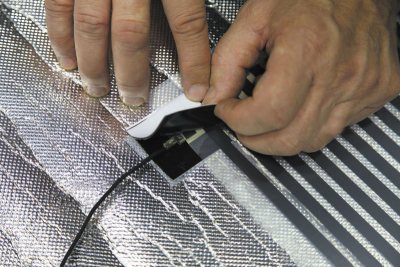

The heat-reflecting layer maximizes the efficiency of the IR film by storing and directing heat in the desired direction.
We have managed to calculate quite real figures for the consumption of electricity for the operation of film warm floors. The costs are not that terrible, but it takes a little work to achieve compliance. First, you need to properly lay the IR film, placing a heat-reflecting layer under it. Thanks to this, the heat generated by it will not go into the concrete screed or other underground structures.
It is also necessary to reduce heat losses, this will be somewhat more difficult. First, you need to work on the walls of the dwelling, since here the losses can be up to 15-20%. This figure is reduced due to the installation of thermal insulation and an additional layer of brick. It is best if all this is taken into account even at the stage of building the home ownership, otherwise you will incur additional costs.
The insulation of the ceiling will help to reduce the energy consumption of the film warm floor, from where another 10-15% of thermal energy can be lost. Ceiling structures should be insulated with basalt wool or any other similar insulation, and in two layers. This insulation will help reduce energy costs and prevent heat from leaking outside the home.
To reduce heat losses and a corresponding decrease in energy consumption for the operation of the film floor, you should work on other elements:
- Doors - you need to either install normal entrance doors in the house or endure the cost of electric heating;
- Floors are another place through which heat energy can flow. This leakage is prevented with additional concrete screed, as well as with serious thermal insulation materials. In wooden buildings, only thermal insulation is used, on top of which the boards of the subfloor are laid - then the film is spread, a topcoat is placed on top of it;
- A large area of window openings and extra windows - all this contributes to an increase in energy consumption for the operation of film warm floors. Excess windows should be laid, and too wide openings should be made narrower - the minimum ratio between the area of the windows and the area of the floor is the cause of losses.
All these measures will help prevent thermal energy leaks and reduce energy consumption.
Power
An electric floor has two capacities in kilowatts per hour per square meter - the first "heat transfer" and the second "consumption". But due to the close to 100% efficiency, these figures are almost identical. In fact, the TP converts all the electricity into heat or infrared rays, which then heat the surfaces in the room.
The heat transfer power of the warm floor in the room depends on:
- the thickness of the screed and floor finish;
- the step of laying the cable or the configuration of the layout of the film (mats) on the floor;
- shares of the active area of the system from the entire square of the room
When used as the main heat source, electric and infrared underfloor heating typically covers about 70% of the floor area. And if such a system is used for local heating, then this percentage turns out to be even less.All this will have to be carefully considered when calculating the actual consumption of electricity.
Underfloor heating costs depending on the area
The total power consumption of the electric floor depends on:
- the quality of the insulation of the room, as well as the presence of windows and doors in it;
- weather conditions outside the window;
- thermostat settings;
- the number of people in the house.
If the level of heat loss in the room is minimal, then less heat is required to maintain comfort in it. It is not worth neglecting here the adjustment of plastic windows to the "summer / winter" mode and seasonal reconfiguration of ventilation.
Comparison of energy costs for different types of floors
Calculation of energy consumption of a film infrared warm floor
It is quite simple to calculate the energy costs for the operation of an infrared underfloor heating. True, here one should take into account the future operating mode of the floor heating system: round-the-clock or forced. In the first case, the costs will be higher, but only 1 out of every 5 homeowners who have installed an infrared heated floor uses this mode. The fact is that most of us spend most of the day at work, children at school, so maintaining a comfortable temperature in an empty apartment is not at all necessary.
Calculation example
To calculate how much a warm floor consumes, you need:
- Determine the active area of the underfloor heating system.
- Multiply it by the power per square meter indicated in the passport.
As a result, the maximum possible power consumption will be obtained. However, the floor will consume so much kW / h only if it is turned on at full and without thermostat regulation. But in reality, the electrical TP system works for 5–20 minutes per hour. And the actual consumption will be several times less.
Electricity consumption schedule
There is nothing complicated in these calculations. It is often more difficult to figure out why the gas boiler is dying out or how to connect the boiler. With underfloor heating, everything is easier.
With a heating area of 12 m2 and a TP power of 150 W / m2, we obtain a nominal flow rate for the room - 1.8 kW / h. But in fact, such a heating floor will consume about 0.3 kW for every hour of use. It will warm up for 10 minutes, and then cool down for 50 minutes. However, a lot here depends on the temperature outside the window and the thermostat settings.
Comparison of different heating systems
reference
The only thing that should be said in more detail is the energy consumption coefficient of 0.35, which is provided by the thermostat for the warm floor. Some consumers will ask themselves: why is this figure indicated? The fact is that the principle of operation of the thermostat is as follows - a film infrared warm floor is heated to a predetermined temperature from 10 seconds to 1 minute. After that, the thermostat automatically cuts off the power and natural cooling of the thermal film occurs. This process takes from 2 to 10 minutes (depending on the degree of thermal insulation of the house and, again, the set temperature). It is clear that at this time the film floor does not consume energy at all. When the temperature sensor is triggered, the thermostat turns on the floor again, and it heats up again from 10 to 60 seconds. Then again shutdown, etc. As you can see, the coefficient 0.35 is the average indicator of real energy consumption.
In the article, we will answer the most popular question about infrared heated floors: how much does a warm floor consume?
Let's consider what the consumption depends on and how to save energy when using a heating system for film warm floors.
Content
Device and principles of operation
The warm infrared film floor is a polyethylene heat-resistant film containing strips of carbon paste, which is connected by copper busbars, also soldered into the film.It is through these tires that an electric current is supplied to the carbon material (most often carbon).
You can find out the price and buy heating equipment and related products from us. Write, call and come to one of the shops in your city. Delivery throughout the territory of the Russian Federation and the CIS countries.
IR film for underfloor heating
Due to the fact that the current passes through the carbon, it generates maximum heat. The stripes are combined by a couple of pieces in one block. You can cut them along the dividing strip between the blocks, which greatly facilitates installation.
This design is also advantageous in that if one or more strips are damaged, the rest of the belt will function. Since the gap between the strips is small, even if several parts are broken, the floor will keep evenly warm.
Infrared film cutting line
This heating system is environmentally friendly.
In many countries of the world, scientists have long provided justification and evidence of the beneficial effects of infrared rays on all living organisms and their absolute harmlessness to human health.
The table below shows the technical indicators and characteristics of the IR underfloor heating.
| Characteristic | Features of the |
| power consumption 1 m², W / m.h | 45-67 |
| thermal film width, cm | 50 |
| maximum permissible length of a strip of thermal film, m | 8 |
| melting temperature of thermofilm, ° С | 130 |
| food | 220 V / 50 Hz |
| IR heating wavelength, μm | 5-20 |
The amount of electricity consumed by an infrared heated floor depends on the size of the site and the mode of operation. Various companies producing such heating systems offer their own modifications of IR floors. They all have approximately identical characteristics and indicators, so which one to give preference to depends only on you.
Thermal film thickness - 0.4 mm. Thanks to this, it can be mounted under parquet, tiles, laminate, linoleum. In addition, you can install the film on walls and ceilings in order to heat the entire room as much as possible.
Calculation of the cost of consumption of underfloor heating
Let's calculate the cost of consumption of a film heated floor with a capacity of 220 W / m2, used as the main heating. The thermal film is laid on a free area not occupied by cabinet furniture. The room was built and insulated in accordance with the requirements of SNiP. The calculated air temperature in the room is + 22 ... + 24 ° С.
Initial data
- Film power underfloor heating: 220 W / sq. M.
- Electricity cost: 3.37 rubles / kW
To calculate energy consumption, we will use the formula:
Energy consumption = (underfloor heating power) * (heating area) * (heating time) / 1000
Consider two options for using a film warm floor and calculate the cost of electricity consumption for underfloor heating for each.
Electricity consumption calculation
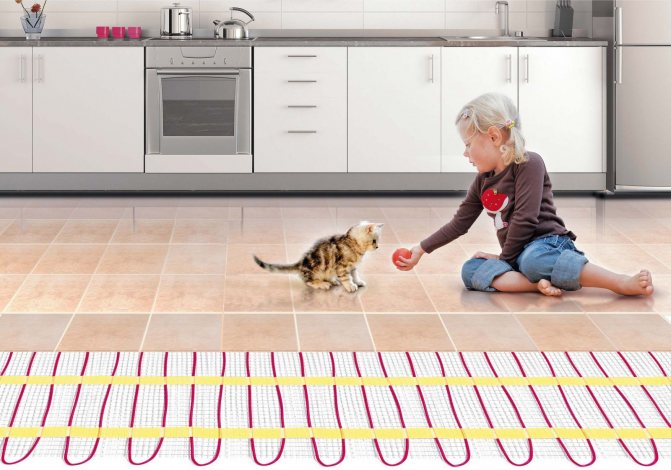

Conventionally, the operating time of underfloor heating is taken at the rate of 6 hours per day
For a living space of the first floor with an area of 20 m2, 14 m2 must be heated as the main source.
The specific power of the underfloor heating for this type of room is 150 W / m2. Accordingly, the electricity consumption for the floor heating system will be: 150 * 14 = 2100 W.
Conventionally, the floors are turned on for 6 hours per day, then the monthly rate will be 6 * 2.1 * 30 = 378 kW / h. Multiply the resulting number by the cost of 1 kW in the region and get the cost of electricity costs in this room.
Provided that a thermostat is included in the heating system and the operation is set to economy mode, the electricity consumption of the floors can be reduced by 40%.
It is more difficult to calculate the power of a water-heated floor system, in these calculations it is better to trust an online calculator or consult a specialist. For information on how to calculate the power for film floors, see this video:
Warm floor is always on
In this case, the consumption of a film warm floor will be 0.22 kW / h.Estimated 24-hour energy consumption for 30 days will be 158.4 kW / sq. M. (533.8 rubles / sq. M.)
But this is only if the heat continuously escapes through an open window or a film heat-insulated floor is connected without a thermostat.
Attention!
Connect a film underfloor heating without a thermostat as a comfortable or main heating not safe... Uncontrolled heating of the film can damage both the film itself and the floor covering.
About film heaters
Calculation of the amount of infrared film is much easier and comes down to the selection of heating material in terms of size and specific heat transfer:
- Calculate the heat energy requirement of the premises (section one of this publication).
- Sketch the layout of a room with stationary furniture. Calculate the size and squaring of the free area.
- Film heat-insulated floors are laid out with a distance of 15-20 cm from the walls. Draw these stripes on the sketch and subtract their sizes from the free area.
- The last task is to place an infrared film of the required total power in the remaining area. Select rolls of the required width and heat transfer from the manufacturer's catalog.
Reference. The film of the famous brand Caleo is capable of delivering from 130 to 230 W per 1 m² of the heating element. Width - 50, 80 and 100 cm.
Please note that the thermal film can only be cut across, guided by special lines (interval - 250 mm). Neighboring canvases can be laid end-to-end or with a calculated interval, but not overlapping. For the bedroom from our example, the amount of film is calculated as follows:
- The required heat transfer of the floor circuit is 1.08 kW. If you take a product with a heat transfer of 130 W / m², you will need 1080/130 = 8.3 m² of a film heater. Taking into account the stock - 9 m².
- Roll width - 0.5 m.To dial 9 squares, you need to take a film with a length of 18 m.
- Since there is 15 m² of free space in the bedroom, this type of heater is fine.
The principle of operation of the thermostat for a warm floor
The principle of operation of the thermostat is simple - after the sensor has recorded the required thermal indicators, the thermostat stops the power supply until the temperature of the heating element drops by 1-2 degrees (this value can be changed in the thermostat settings). Then the power supply resumes.
The graph * clearly demonstrates the principle of operation of the underfloor heating system with a connected thermostat.
Dealing with the temperature: how to calculate an electric warm floor
The upper limit of the temperature range is at around 45-55 degrees Celsius. Experienced builders recommend that a specific value reflects the need for a particular room for heat. Even a minor mistake will turn the room into a solarium or make it look like the Northern Polis.
Regardless of the selected indicator, the warm floor is equipped with a temperature level regulator. It is desirable that the heating system includes at least two regulators.
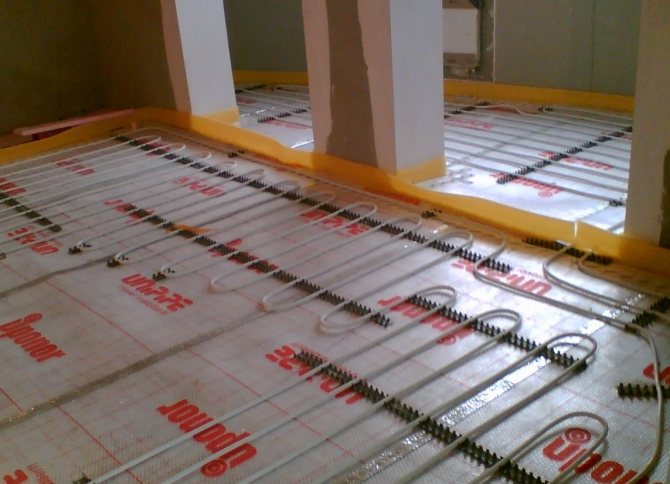

In this case, you can more quickly respond to changes in environmental conditions. While one thermal regulator fixes t of the carrier of thermal energy, and the second - the temperature background of the "return".
An indicator of the normal operation of the entire system will be the difference between the readings of both thermometers at a level of up to 10 degrees Celsius.
In addition, it will not be superfluous to pay attention to a number of practical tips below:
- In the toilet and bathroom, the permissible level of t does not exceed + 33C;
- If the premises provide for a long stay of citizens, then in this case t is no more than + 29C;
- In the boundary functional zones, this mark is at the level of + 35C.
Correctly selected temperature level will ensure a comfortable stay in an office, private house, retail space or apartment. To do this, it is necessary to take into account the area of the room, the material used, the need for heating and its functional purpose.
How To Reduce Electricity Costs When Using Film
Power selection
For comfortable floor heating in city apartments, a film with a capacity of 150 W / m2 is sufficient. Film underfloor heating is installed in places where heating is required.
For the main heating and comfortable floor heating, film warm floors with a power of 220 W / m2 are used, for example, Marpe Normal GSM thermal film. In this case, the recommendations of manufacturers for the installation of heating systems on the ground floors, in country houses and balconies with the use of continuous carbon films (for example, Marpe Black Heat), which have additional layers of protection against moisture, should be followed. The coverage area is about 70% of the total area of the room.
Warming the room
When using infrared underfloor heating as the main heating in a country house, the ventilation of the room will be of great importance. If all of the generated heat escapes through the slots, the film will work longer to maintain the required temperature and, accordingly, the amount of electricity is consumed much higher.
To save energy, it is necessary to use heaters to reduce heat loss. Double and triple glazed windows and tightly fitted doors avoid large amounts of heat loss.
Choice of flooring
It should be borne in mind that different types of flooring have their own thermal conductivity.
Using an insulating layer
When installing infrared underfloor heating both in suburban and apartment buildings, it is recommended to use a heat-insulating substrate. It is made of chemically cross-linked rigid polyethylene foam with a closed porous structure several millimeters thick and an unmetallized reflective layer. Such a substrate not only protects the film from condensation and short circuits, but also allows all the heat to be directed into the room, excluding the heating of the interfloor overlap, while saving up to 40% of electricity compared to cable heating systems.
For full heating of the room, it is enough to cover about 70% of the floor area of the room. Installation of heating elements under furniture and household appliances is not only inexpedient in terms of energy consumption, but also undesirable due to the possibility of damage to the floor covering or overheating of the film.
Types, advantages and disadvantages
Despite the fact that the IR film floor began to be used relatively recently, on the market you can find several varieties of such a heating system in terms of the parameters of the heating element that underlies it:
- carbon - carbon-graphite;
- bimetallic - copper and aluminum.
The carbon-graphite system is more widespread.
By purchasing an IR film floor, you will receive a lot of advantages:
- installation and connection are quite simple and quick;
- suitable for many floor coverings: tiles, laminate, parquet, linoleum;
- no electromagnetic radiation;
- can be easily installed on any surface: vertical, horizontal, inclined;
- the entire floor surface warms up evenly;
- it is highly durable and reliable;
- you can make the connection yourself;
- unlike other types of underfloor heating, you will save 10 to 20% in energy and finance;
- such a floor can be mounted in absolutely any room, even wet;
- destroys all kinds of unpleasant odors: paint, tobacco, etc.;
- has an anti-allergic effect;
- ionizes the air;
- works without any noise;
- characterized by high heat transfer.
Be sure to follow all the rules for connecting and operating an IR underfloor heating!
- It is recommended to use it as an auxiliary heating source, and not the main one (since such a system is characterized by fast heating and the same fast cooling).
- Cannot withstand mechanical stress and damage.

